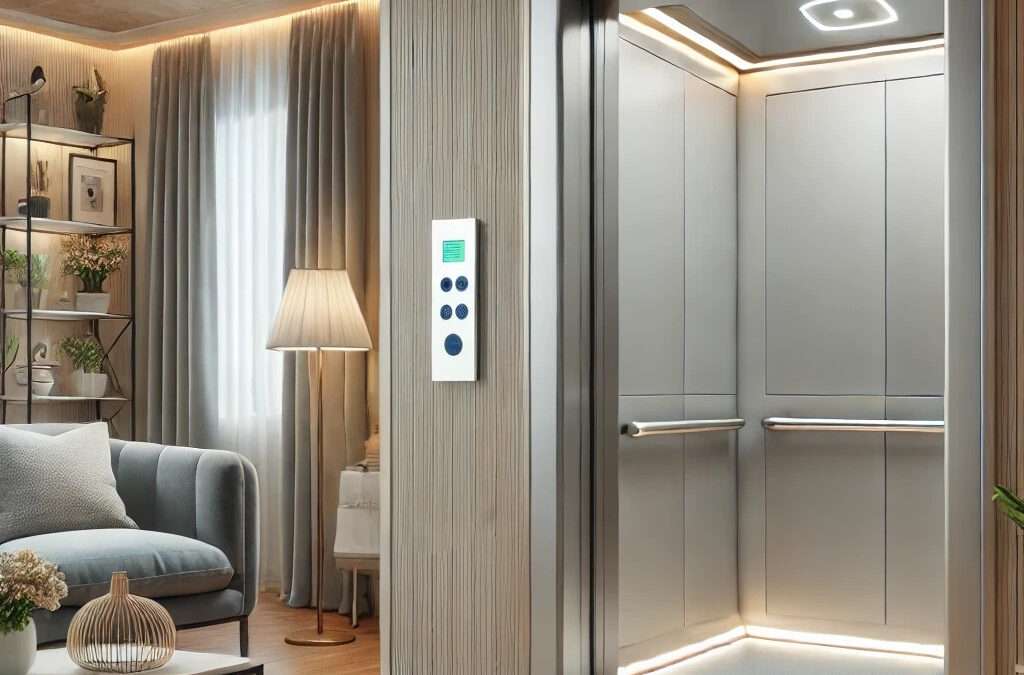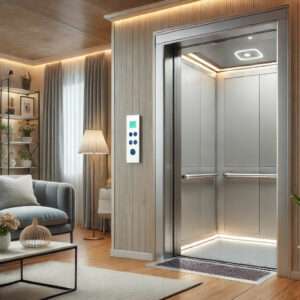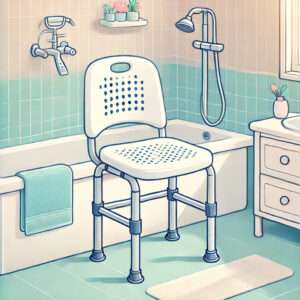Introduction
Elevate Your Home: The Modern Solution for Residential Mobility
Have you ever imagined how installing a home elevator could transform your daily life? Home or in-home or residential elevators are becoming popular in many houses today. They offer a convenient and stylish way to move between floors, making your home more accessible and adding a touch of luxury.
Why Consider a Home Elevator?
Life can throw unexpected challenges our way. Maybe you’re planning for the future, accommodating aging family members, or simply tired of lugging heavy items up the stairs. A home elevator addresses these concerns by providing easy access to all levels of your home. It’s not just a luxury—it’s a practical solution for modern living.
The Growing Trend of Residential Elevators
Did you know that the installation of home elevators has increased by over 20% in the past few years? This surge is partly due to an aging population that prefers to “age in place” rather than move to single-story homes or assisted living facilities. Additionally, homeowners want to enhance their property’s value and appeal with modern amenities.
What This Guide Offers
This comprehensive guide will explore everything you need to know about home elevators. We’ll discuss the benefits, delve into the available types, and cover essential factors to consider before installation. We aim to equip you with the knowledge to make an informed decision that’s right for your home and lifestyle.
Common Questions About Home Elevators
You might be asking:
- Is my home suitable for an elevator?
- How much will it cost to install and maintain?
- What are the safety features?
We’ll answer these questions and provide tips to help you navigate the process smoothly.
Making Accessibility Easy and Stylish
Transitioning to a home with an elevator doesn’t have to be overwhelming. Technological advances make home elevators more compact, efficient, and customizable. Whether you’re renovating or building a new home, there’s likely an option that fits your needs.
By the end of this guide, you’ll clearly understand how a home elevator can enhance your quality of life. So, let’s dive in and explore the possibilities that await!
Benefits of Installing a Home Elevator
Enhanced Accessibility and Mobility
Aging in Place with Ease
As we age, navigating stairs can become challenging. Installing a home elevator allows you to enjoy every part of your multi-story home without worry.
- Example: Consider Jane, who loves her two-story house but has knee problems. A home elevator lets her access her bedroom upstairs comfortably, letting her stay in her beloved home longer.
Convenience for Daily Living
It’s not just about aging. Carrying heavy groceries, furniture, or laundry up and down the stairs can be tiring and risky.
- Tip: Use the elevator to move bulky items between floors effortlessly, saving time and reducing the risk of accidents.
Answering Common Questions
- Q: “Is a home elevator only beneficial for the elderly?”
- A: Not at all! While they greatly assist seniors, home elevators offer convenience for families with young children, people with disabilities, and anyone who wants to enhance their home’s functionality.
Increased Property Value
Boosting Your Home’s Market Appeal
A home elevator can make your property stand out if you sell.
- Statistic: According to some real estate experts, homes equipped with elevators can see an increase in property value by up to 10%.
Attracting a Broader Range of Buyers
Potential buyers may see the elevator as a luxury feature or a necessary amenity for their family’s needs.
- Example: A family with an elderly member might choose your home over another because of the installed elevator.
Answering Common Questions
- Q: “Will I get a return on investment from installing an elevator?”
- A: Yes, many homeowners find that the added value and appeal can lead to a higher selling price, making it a worthwhile investment.
Space-Saving Designs
Modern Elevators Fit Almost Anywhere
Worried about space? Modern home elevators come in compact designs that can fit into tight areas.
- Tip: Explore pneumatic vacuum elevators, which have a smaller footprint and don’t require a machine room.
Blending with Your Home’s Aesthetic
Customize your elevator to match your interior design, making it a seamless addition.
- Example: The Smiths installed an elevator with wood paneling that matches their home’s classic decor.
Answering Common Questions
- Q: “Do I need a large space to install an elevator?”
- A: No, many elevators are designed for residential spaces and can be installed with minimal alterations.
Safety and Security
Advanced Safety Features
Home elevators come equipped with features like emergency stop buttons, door sensors, and backup power systems.
- Example: In a power outage, backup systems ensure the elevator safely reaches the nearest floor.
Reducing the Risk of Accidents
Stairs can be hazardous, especially for young children and the elderly.
- Statistic: According to the National Safety Council, over 1 million injuries occur annually due to stair-related falls.
Answering Common Questions
- Q: “Are home elevators safe for kids?”
- A: Yes, with proper safety features and supervision, elevators can be safer than stairs for children.
Enhancing Lifestyle and Luxury
A Touch of Elegance
An elevator can add a sense of luxury and sophistication to your home.
- Tip: Choose premium materials like glass or stainless steel for a modern look.
Future-Proofing Your Home
Installing an elevator prepares your home for future needs, making it adaptable as your circumstances change.
- Example: The Johnsons aren’t facing mobility issues now, but they installed an elevator to ensure their home meets their needs for years to come.
By considering a home elevator, you’re investing in convenience, safety, and the future value of your property. It’s a feature that offers immediate benefits and long-term advantages, making your daily life easier and your home more appealing.
Types of Home Elevators
Understanding the different types of home elevators can help you choose the one that best fits your needs and home design. Let’s explore the most common types available.
Hydraulic Elevators
How Do They Work?
Hydraulic elevators use a hydraulic piston to raise and lower the elevator car. The system operates by pumping hydraulic fluid into a cylinder, moving the piston and the attached car smoothly between floors.
- Tip: Hydraulic elevators are known for their quiet and smooth operation, making them a popular choice for residential settings.
Pros and Cons
-
- Pros: Smooth and quiet ride.
- Capable of lifting heavy loads.
- It is ideal for homes up to five floors.
- Cons: Requires a machine room to house equipment.
- Regular maintenance is needed to prevent hydraulic fluid leaks.
Common Questions
- Q: Do hydraulic elevators take up a lot of space?
- A: They do require a machine room, which can be located in a basement or garage to save space inside the home.
Traction Elevators
How Do They Work?
Traction elevators, called cable-driven elevators, use steel ropes or belts and a counterweight system to move the elevator car.
- Example: Similar to elevators used in commercial buildings but scaled for residential use.
Pros and Cons
-
- Pros: Energy-efficient due to the counterweight.
- No machine room is required; equipment fits within the shaft.
- Suitable for taller homes with multiple floors.
- Cons: Installation can be more complex.
- Generally more expensive than hydraulic elevators.
Common Questions
- Q: Are traction elevators noisy?
- A: Modern traction elevators are designed to operate quietly, but they might produce more noise compared to hydraulic models.
Pneumatic Vacuum Elevators
How Do They Work?
Pneumatic elevators move the car using air pressure. A vacuum system above the cab removes air to lift the car, and air pressure below the cab lowers it.
- Tip: These elevators have a futuristic, transparent design that can be a stylish addition to your home.
Pros and Cons
-
- Pros: Compact and space-saving; no pit or machine room needed.
- Quick installation, often within a few days.
- Energy-efficient, especially during descent.
- Cons: Limited weight capacity.
- Best suited for homes with up to three floors.
Common Questions
- Q: Can pneumatic elevators be installed in existing homes?
- A: Yes! Their self-supporting structure makes them ideal for retrofitting without significant construction.
Winding Drum and Chain Drive Elevators
How Do They Work?
These elevators use a motor to wind a drum or chain, lifting and lowering the car along a track.
- Example: Think of it like a yo-yo, where winding the string lifts the yo-yo upward.
Pros and Cons
-
- Pros: Often more affordable.
- There is no need for a separate machine room.
- Cons: May produce more noise.
- The ride may not be as smooth as other types.
Common Questions
- Q: Are winding drum elevators safe?
- A: Yes, they include safety features like emergency brakes and door interlocks. Regular maintenance ensures they operate safely.
Machine Room-Less (MRL) Elevators
How Do They Work?
MRL elevators place the machinery in the hoistway, eliminating the need for a separate machine room.
- Tip: An excellent option if space is at a premium in your home.
Pros and Cons
-
- Pros: Saves space.
- Energy-efficient models are available.
- Cons: May have higher upfront costs.
- Maintenance can be more challenging due to equipment placement.
Common Questions
- Q: Is maintenance more difficult with MRL elevators?
- A: Maintenance access can be tighter, but professional technicians are trained to efficiently service these types of elevators.
Tips for Choosing the Right Elevator
- Assess Your Space: Determine where the elevator will go and how much room you have.
- Consider Your Needs: Consider load capacity, speed, and who will use the elevator.
- Budget Wisely: Factor in installation and ongoing maintenance costs.
- Aesthetic Preferences: Choose a style that complements your home’s design.
Answering More Common Questions
- Q: Which type of elevator is most energy-efficient?
- A: Pneumatic and traction elevators are generally more energy-efficient, especially during descent when they use minimal power.
- Q: Do I need a machine room?
- A: It depends on the type. Hydraulic elevators require a machine room, while pneumatic, MRL and some traction elevators do not.
- Q: Can I install an elevator during a renovation?
- A: Many elevators can be retrofitted into existing homes with proper planning.
By exploring these options, you can find a home elevator that fits your lifestyle and enhances your home’s functionality. Whether you prioritize space-saving designs, quiet operation, or aesthetic appeal, an elevator type is just right for you.
Factors to Consider When Installing a Home Elevator
Installing a home elevator is a significant decision that involves various considerations. Let’s explore the key factors to keep in mind to ensure a smooth installation process and a final result that meets your needs.
Space and Structural Requirements
Assessing Available Space
First and foremost, you’ll need to determine where the elevator will go.
- Tip: Look for stacked closets or unused spaces that align vertically between floors.
- Example: Some homeowners repurpose a portion of their staircase or install an external elevator shaft.
Structural Modifications
Your home’s structure may need adjustments to accommodate an elevator.
-
- Considerations: Load-Bearing Walls: Modifications may affect structural integrity.
- Foundation Support: Ensure your foundation can handle the additional weight.
Space-Saving Solutions
If space is limited, there are compact elevator options.
- Tip: Pneumatic vacuum elevators or shaftless models require less space and minimal construction.
Common Questions
- Q: Can I install an elevator in an existing home without major renovations?
- A: Yes, many elevators are designed for retrofit installations, but some structural modifications may be necessary.
Cost and Budgeting
Installation Costs
Understanding the financial commitment is crucial.
- Factors Affecting Cost:
- Type of Elevator: Hydraulic, traction, pneumatic, etc.
- Number of Stops: More floors typically mean higher costs.
- Customization: Premium materials and finishes increase the price.
- Example: A basic two-stop hydraulic elevator may cost around $20,000, while a custom glass elevator costs $50,000.
Long-Term Expenses
Consider ongoing costs beyond installation.
- Maintenance: Regular servicing to keep the elevator safe and operational.
- Energy Consumption: Electricity usage varies by elevator type.
Financing Options
Making the investment more manageable.
- Tip: Some companies offer financing plans, or you might explore home improvement loans.
Common Questions
- Q: Are there grants or assistance programs for installing home elevators?
- A: In some areas, grants are available for accessibility improvements. Check with local government agencies.
Legal Regulations and Permits
Building Codes and Standards
Compliance is non-negotiable.
-
- Requirements: Adherence to local building codes.
- Compliance with safety standards like ASME A17.1.
Permit Process
You’ll need official approval before installation.
- Steps:
- Submit detailed plans to the local building department.
- Obtain necessary permits and schedule inspections.
- Tip: Your elevator contractor can often handle the permit process.
Zoning Restrictions
Some neighborhoods have specific rules.
-
- Considerations: Homeowners Association (HOA) guidelines.
- Historic district regulations.
Common Questions
- Q: Do I need a permit to install a home elevator?
- A: Yes, permits are typically required to ensure safety and code compliance.
Safety Features
Essential Safety Components
Safety should be a top priority.
-
- Key Features: Emergency Brake Systems: Stop the elevator if it moves too quickly.
- Door Interlocks: Prevent doors from opening between floors.
- Backup Power Supply: Keeps the elevator operational during power outages.
Additional Safety Enhancements
For extra peace of mind.
-
- Options: Telephone or Intercom: For emergencies.
- Automatic Lowering Systems: Gently brings the elevator to the nearest floor during power loss.
Common Questions
- Q: Are home elevators safe for children and pets?
- A: Yes, when equipped with proper safety features and used correctly.
Maintenance and Servicing
Regular Maintenance Importance
Keep your elevator running smoothly.
- Tip: Schedule annual inspections and maintenance with certified technicians.
Finding a Reliable Service Provider
Choose a company you can trust.
-
- Considerations:Experience: Look for providers specializing in residential elevators.
- Availability: Opt for companies offering 24/7 emergency services.
Warranty and Support
Understand what’s covered.
- Tip: Read the warranty details carefully and consider extended warranty options.
Common Questions
- Q: How much does annual maintenance cost?
- A: Costs can range from $200 to $500 annually, depending on the elevator type and service plan.
Energy Efficiency
Operating Costs
Be mindful of ongoing energy consumption.
-
- Comparison: Hydraulic Elevators May use more energy due to the hydraulic pump.
- Traction Elevators: Generally more energy-efficient.
Eco-Friendly Options
Minimize your environmental footprint.
- Tip: Consider elevators with energy-saving features like LED lighting and standby modes.
Common Questions
- Q: Will my electricity bill increase significantly?
- A: Most home elevators have minimal impact on electricity bills, similar to running a household appliance.
Aesthetic and Design Considerations
Customization Options
Make the elevator complement your home’s style.
-
- Choices: Cabin Materials: Wood, glass, metal.
- Lighting: LED, ambient.
- Controls: Touchscreen panels or traditional buttons.
Integration with Home Decor
Ensure a seamless look.
- Tip: Work with designers to match the elevator finishes with your home’s interior.
Common Questions
- Q: Can I personalize the elevator’s interior?
- A: Absolutely! Many companies offer customization to suit your preferences.
Future Needs and Resale Value
Planning Ahead
Think long-term.
-
- Considerations: Aging in Place: Will the elevator accommodate mobility aids?
- Family Changes: Anticipate growing families or caring for elderly relatives.
Impact on Property Value
An elevator can be a selling point.
- Statistic: Homes with elevators can see a property value increase of up to 10%.
Common Questions
- Q: Will installing an elevator make my home more attractive to buyers?
- A: Yes, especially to buyers looking for accessibility features or luxury amenities.
Insurance and Liability
Updating Your Home Insurance
Protect your investment.
- Tip: Notify your insurance company about the new installation to adjust your coverage.
Liability Considerations
Ensure safety for all users.
-
- Considerations: Proper Signage, Instructions, and weight limits.
- Regular Inspections: Prevent accidents due to malfunctions.
Common Questions
- Q: Does a home elevator affect my insurance premiums?
- A: It may. Check with your insurer to understand any changes in your policy.
Selecting the Right Installer
Research and Recommendations
Choose a reputable installer.
- Tip: Read reviews, ask for references, and check certifications.
Experience and Expertise
Ensure quality workmanship.
-
- Considerations:Specialization: Does the installer specialize in residential elevators?
- Portfolio: Ask to see past projects.
Common Questions
- Q: Should I get multiple quotes before deciding?
- A: Yes, comparing quotes can help you find the best value and service.
By carefully considering these factors, you’ll be well-prepared to embark on installing a home elevator. It’s an investment that can greatly enhance your daily life, add value to your property, and provide convenience for years to come.
The Installation Process
Installing a home elevator is a significant project, but understanding the steps involved can make the process smoother and less intimidating. Let’s walk through the typical stages of installation, from initial planning to final testing.
Planning and Design
Initial Consultation
The journey begins with an initial consultation with a professional elevator company.
- Tip: Prepare a list of your needs and questions before the meeting to maximize the consultation.
- What to Expect: Assessment of Your Home: The consultant will evaluate your home’s layout, structure, and space availability.
- Discussion of Needs: You’ll discuss your reasons for installing an elevator, such as accessibility, convenience, or luxury.
Customization Options
Next, you’ll work on designing an elevator that fits your home’s aesthetic and functional requirements.
- Choices Include:
- Elevator Type: Decide between hydraulic, traction, pneumatic, or other types based on your needs and home structure.
- Cabin Design: Select materials, finishes, lighting, and fixtures that match your home’s decor.
- Features: Consider additional features like touch-screen controls, voice activation, or smart home integration.
- Example: The Andersons chose a glass panoramic elevator to complement their modern home design, creating a stunning focal point in their living area.
Obtaining Permits and Approvals
Before construction begins, necessary permits and approvals must be secured.
- Steps:
- Submit Plans: Your installer will submit detailed plans to local building authorities.
- Review Period: There may be a waiting period while your application is reviewed.
- Approval: Once approved, you can proceed with installation.
- Tip: Your elevator company often handles the permit process, but staying informed helps avoid delays.
Common Questions
- Q: How long does the planning phase take?
- A: It can take anywhere from a few weeks to a couple of months, depending on the complexity of the project and the speed of permit approvals.
Construction Phase
Preparing the Site
Once planning is complete, the physical work begins.
- Site Preparation Includes:
- Creating the Shaft: If your elevator requires a shaft, builders will construct it according to the specifications.
- Modifying Structure: Structural changes, like reinforcing floors or cutting openings between levels, are necessary.
- Example: In existing homes, installers may use non-invasive methods to minimize disruption, such as modular shafts assembled on-site.
Installing Mechanical Components
With the site prepared, the mechanical installation proceeds.
-
- Key Steps: Installing the Elevator Car and Rails: The car is assembled and set onto guide rails within the shaft.
- Setting Up the Drive System: Depending on the type, this could be hydraulic pumps, cables, or pneumatic systems.
- Electrical Wiring: Electricians connect the elevator to your home’s power supply and install control panels.
Ensuring Safety Measures
Safety installations are critical.
-
- Measures Include Emergency Systems: Installing backup batteries, alarms, and communication devices.
- Testing Safety Features: Verifying the functioning of door interlocks, emergency brakes, and sensors.
Timeline Expectations
Understanding the time frame helps with planning.
- Average Duration:
- Simple Installations: 2 to 4 weeks.
- Complex Projects: Up to several months, especially if extensive construction is needed.
- Tip: Discuss the timeline with your installer to set realistic expectations and plan accordingly.
Minimizing Disruptions
Living through construction can be challenging.
-
- Strategies: Clear Communication: Regular updates from your installer help you anticipate disruptions.
- Temporary Adjustments: You may need to adjust your living arrangements, like setting up a temporary kitchen if access is restricted.
Common Questions
- Q: Will I need to move out during installation?
- A: Usually not. Most installations are designed to minimize disruption, allowing you to stay home.
- Q: How noisy is the construction process?
- A: There will be some noise during construction hours, but installers strive to keep it as low as possible.
Testing and Compliance
Final Inspections
It must pass final inspections before you can start using your new elevator.
- What Happens:
- Internal Testing: The installer runs the elevator through various tests to ensure all systems work correctly.
- Official Inspection: A certified inspector verifies that the installation meets all safety codes and regulations.
- Tip: Be present during the official inspection to address any last-minute questions or concerns.
User Training
Knowing how to operate your elevator safely is essential.
- Training Includes:
- Operating Instructions: Use the control panel, call buttons, and any special features.
- Emergency Procedures: What to do in case of a power outage or if the elevator stops between floors.
- Example: The installer may provide a user manual and demonstrate how to use the elevator’s emergency communication system.
Documentation and Warranty
Keep all documentation in a safe place.
-
- Important Papers: Operation Manuals: These are for future reference on features and troubleshooting.
- Warranty Information: Details on coverage and how to request service.
- Maintenance Schedule: Recommended service intervals to keep the elevator in top condition.
Common Questions
- Q: What if issues are found during the final inspection?
- A: The installer will address any issues promptly. A re-inspection may be scheduled to ensure compliance.
- Q: Do I need special insurance after installation?
- A: It’s wise to inform your home insurance provider about the new elevator so that your coverage can be adjusted if necessary.
After Installation
Regular Maintenance
Your elevator will require routine maintenance.
- Scheduling Service:
- Frequency: Typically, once or twice a year.
- What It Includes: Checking mechanical parts and safety features and performing necessary adjustments.
- Tip: Set reminders for maintenance appointments to prolong the life of your elevator.
Enjoying Your New Elevator
Now comes the best part—using your elevator!
-
- Benefits You’ll Experience: Enhanced Mobility: Effortlessly move between floors.
- Increased Home Value: Enjoy the added luxury and appeal.
- Convenience: Simplify daily tasks like moving laundry or groceries.
Sharing Your Experience
Consider sharing your positive experience.
-
- Ways to Share: Provide Testimonials: Help others by reviewing your installer.
- Offer Tours: If comfortable, show friends or neighbors your new addition.
By understanding each step of the installation process, you can approach your home elevator project with confidence. From planning and design to final testing, knowing what to expect helps ensure a successful installation and many years of enjoyment.
Costs Associated with Home Elevators
Understanding the costs of installing and maintaining a home elevator is crucial for making an informed decision. Let’s break down the various expenses you can expect, from the initial purchase to ongoing maintenance.
Initial Purchase and Installation Costs
Price Variations: What Influences the Cost?
The cost of a home elevator can vary widely based on several factors.
- Type of Elevator: Hydraulic, traction, pneumatic, and winding drum elevators have different price points.
- Example: A basic pneumatic vacuum elevator might start around $20,000, while a custom traction elevator could exceed $50,000.
- Number of Floors (Stops): More floors mean more complex installations.
- Tip: Limiting the elevator to essential floors can help reduce costs.
- Customization and Materials: High-end finishes and custom designs increase the price.
- Example: Glass doors, luxury lighting, and premium materials add to the overall expense.
- Structural Modifications: Existing homes may require additional construction work.
- Consideration: Building a shaft or reinforcing structures adds to installation costs.
Average Cost Estimates
While prices can vary, here’s a general idea of what you might expect:
- Basic Elevators: $20,000 to $30,000
- Mid-Range Options: $30,000 to $40,000
- High-End Models: $40,000 and up
Financing Options: Making It Affordable
If the upfront cost seems daunting, there are financing options to consider.
- Manufacturer Financing: Some elevator companies offer payment plans.
- Home Equity Loans: Use the equity in your home to finance the elevator.
- Personal Loans: Unsecured loans can cover costs without using your home as collateral.
Common Questions
- Q: Is installing a home elevator a good investment?
- A: Yes, especially if it enhances your quality of life or increases your home’s value. Consider both personal benefits and potential resale value.
- Q: Can I save money by choosing a basic model?
- A: Absolutely. Opting for standard features and finishes can significantly reduce costs.
Operating Costs
Energy Consumption: What to Expect on Your Utility Bill
Home elevators generally don’t consume a lot of energy, but usage can add up.
- Hydraulic Elevators: May use more electricity due to the pump system.
- Traction Elevators: Often more energy-efficient because of counterweights.
- Pneumatic Elevators: Use energy mainly during ascent; descent uses gravity.
Estimated Energy Costs
- Monthly Electricity Cost: Typically between $10 and $15.
- Tip: To save energy, turn off cabin lights when not in use.
Efficiency Tips: Reducing Operating Expenses
- LED Lighting: Use energy-efficient bulbs in the elevator cabin.
- Standby Mode: Some elevators have a standby feature to reduce idle power.
- Regular Maintenance: Well-maintained elevators run more efficiently.
Common Questions
- Q: Will my electricity bill increase significantly after installing an elevator?
- A: Not significantly. Most homeowners notice only a slight increase in their monthly bills.
- Q: Are there energy-efficient models available?
- A: Yes, many manufacturers offer models designed to minimize energy consumption.
Maintenance Expenses
Routine Maintenance: Keeping Your Elevator in Top Shape
Regular maintenance ensures safety and prolongs the life of your elevator.
- Service Frequency: At least once a year.
- What It Includes: Checking mechanical parts, updating software, and inspecting safety features.
- Cost: Annual maintenance can range from $200 to $600, depending on the elevator type and service provider.
Unexpected Repairs
While routine maintenance helps prevent issues, unexpected repairs can occur.
- Typical Repair Costs: Minor repairs might cost a few hundred dollars; major repairs could be $1,000 or more.
- Tip: Address small issues promptly to avoid costly repairs later.
Warranty Considerations: Protecting Your Investment
Most new elevators come with a warranty.
- Standard Warranty: Usually covers parts and labor for one to three years.
- Extended Warranty: Optional plans that extend coverage.
- What to Look For: Coverage Details: Understand what’s included and excluded.
- Service Requirements: Some warranties require regular maintenance by authorized technicians.
Common Questions
- Q: Is maintenance mandatory?
- A: While not legally required, regular maintenance is strongly recommended for safety and longevity.
- Q: Can I perform maintenance myself to save money?
- A: Only qualified technicians should perform maintenance to ensure safety and compliance with regulations.
Insurance and Liability Costs
Updating Your Home Insurance
Adding an elevator may affect your insurance policy.
- Increased Coverage: You might need to increase your dwelling coverage to account for the added value.
- Liability Coverage: Ensure your policy covers potential accidents involving the elevator.
Potential Premium Changes
- Slight Increase: Your premium may increase slightly due to the added risk.
- Tip: Shop around and compare insurance providers to get the best rate.
Common Questions
- Q: Do I need special insurance for a home elevator?
- A: Not special insurance, but you should inform your insurer to adjust your policy accordingly.
Tax Considerations
Possible Tax Deductions
If the elevator is medically necessary, you might qualify for tax deductions.
- Medical Expense Deduction: Elevators installed for medical reasons may be deductible.
- Requirements: Doctor’s Recommendation: Documentation supporting the medical need.
- Improvement vs. Value Increase: Deduction is limited to costs exceeding the property’s value increase.
Consult a Tax Professional
- Tip: Tax laws are complex and vary by location. Consult a professional to understand your eligibility.
Common Questions
- Q: Can I deduct the full cost of the elevator from my taxes?
- A: Only the portion that exceeds any increase in your home’s value, and only if it’s medically necessary.
Long-Term Value
Return on Investment (ROI)
Consider the long-term financial benefits.
- Increased Home Value: Elevators can make your home more attractive to buyers.
- Market Appeal: Appeals to a broader market, including seniors and luxury buyers.
Balancing Costs and Benefits
- Personal Use vs. Resale: Weigh how much you’ll benefit personally against potential resale gains.
- Tip: Personal convenience may outweigh immediate financial ROI if you plan to stay in your home long-term.
Common Questions
- Q: Will I recoup the installation costs when I sell my home?
- A: While you may not recover the full cost, the elevator can increase your home’s value and attract more buyers.
Hidden Costs to Consider
Building Modifications
Structural changes can add to costs.
-
- Examples: Electrical Upgrades: You may need to upgrade your home’s electrical system.
- Flooring Adjustments: Matching flooring around the elevator entrance.
Time and Convenience
- Project Duration: Longer projects might disrupt your daily life.
- Tip: Plan installation during a convenient time to minimize stress.
Common Questions
- Q: Are there any surprise costs I should be aware of?
- A: Always discuss potential additional costs with your installer to avoid surprises.
Tips for Managing Costs
- Get Multiple Quotes: Compare prices from different suppliers and installers.
- Negotiate: Don’t hesitate to negotiate terms and pricing.
- Plan Ahead: Early planning can help you budget and find cost-saving opportunities.
- Ask About Discounts: Inquire about promotions, especially during off-peak seasons.
Final Thoughts on Costs
Investing in a home elevator is a significant financial decision, but the benefits outweigh the costs for many. By understanding all the associated expenses and planning accordingly, you can choose to fit your budget and enhance your lifestyle.
By breaking down the costs associated with home elevators, we hope to provide a clear picture of what to expect financially. Remember, while the upfront costs are considerable, the long-term convenience, safety, and potential increase in property value can make it a worthwhile investment.
Real-Life Examples and Case Studies
Exploring real-life scenarios can help you understand how installing a home elevator can make a significant difference. Let’s examine some case studies highlighting the impact on homeowners’ lives.
Luxury Home Installations
Case Study: Elevating Elegance in the Harris Residence
When the Harris family built their new home, they wanted it to blend luxury and functionality. They installed a glass traction elevator as a centerpiece in their three-story house.
- Impact on Lifestyle:
- The elevator became a stunning architectural feature, impressing guests and adding a modern touch.
- It provided seamless access to their rooftop terrace, enhancing their entertainment space.
- The panoramic views from the glass elevator offered a unique experience of moving between floors.
- Tip: Incorporating an elevator into your home’s initial design allows for greater customization and integration with your overall aesthetic.
Answering Common Questions
- Q: Can an elevator enhance the luxury feel of my home?
- A: Absolutely! With various design options like glass walls and custom finishes, an elevator can be both a practical addition and a statement piece.
Accessibility Transformations
Case Study: Restoring Independence for the Walker Family
After Mr. Walker experienced mobility issues due to a medical condition, the family faced the challenge of navigating their two-story home.
- Outcome:
- Installing a home elevator allowed Mr. Walker to move freely between floors without assistance.
- The family avoided the emotional and financial burden of relocating.
- The elevator’s safety features provided peace of mind for all family members.
- Tip: Home elevators can be retrofitted into existing homes, making them an excellent solution for sudden accessibility needs.
Answering Common Questions
- Q: Is installing an elevator in an older home without major renovations possible?
- A: Yes, many elevators are designed for minimal modifications. Consult with a professional to assess the best option for your home.
Enhancing Property Value
Case Study: Boosting Resale Potential for the Nguyen Family
The Nguyen family planned to sell their home in a competitive market. They installed a stylish pneumatic elevator to increase appeal.
- Impact on Sale:
- Attracted a wider range of potential buyers, including those seeking accessibility features.
- Allowed them to list their home at a higher price point.
- Resulted in a quicker sale compared to similar properties without elevators.
- Tip: Investing in a home elevator can set your property apart, potentially yielding a higher return when selling.
Answering Common Questions
- Q: Will a home elevator significantly impact my home’s resale value?
- A: Yes, it can enhance your home’s marketability and attract buyers looking for modern amenities or accessibility solutions.
Innovative Solutions for Limited Spaces
Case Study: Space-Saving Design in the Lopez Townhouse
Living in a compact urban townhouse, the Lopez family desired the convenience of an elevator without sacrificing space.
- Benefits:
- Opted for a shaftless elevator that fit perfectly into their existing staircase design.
- Installation was quick and required minimal structural changes.
- The elevator blended seamlessly with their home’s contemporary decor.
- Tip: Consider elevators designed for small footprints, like shaftless or pneumatic models, if space is a concern.
Answering Common Questions
- Q: Are there elevator options for homes with limited space?
- A: Yes, some compact models require less space and can be installed without extensive construction.
Family Convenience and Safety
Case Study: Simplifying Life for the Adams Family
With young children and frequent visits from elderly grandparents, the Adams family sought ways to make their home more accessible.
- Advantages:
- The home elevator made transporting strollers, groceries, and luggage easier between floors.
- Reduced the risk of accidents on the stairs for both kids and seniors.
- Enhanced daily living by saving time and effort.
- Tip: A home elevator isn’t just for luxury or accessibility needs—it can improve convenience for busy families.
Answering Common Questions
- Q: Is installing an elevator beneficial for families without immediate mobility issues?
- A: Definitely! It adds convenience, enhances safety, and can future-proof your home for changing needs.
Overcoming Installation Challenges
Case Study: Custom Solutions for the Patel Family’s Historic Home
The Patel family lived in a beautiful historic home but faced challenges integrating modern amenities.
- Solutions:
- Worked with specialists to install a traction elevator without altering the home’s exterior.
- Choose materials and finishes that match the home’s classic interior design.
- Successfully upgraded their home while preserving its historic charm.
- Tip: Experienced professionals can provide customized solutions that respect your home’s architectural integrity.
Answering Common Questions
- Q: Can I install an elevator without compromising my home’s design?
- A: Yes, elevators can be customized to match your home’s style, whether it’s modern, traditional, or historic.
Lessons Learned from Homeowners
Start Planning Early
- Experience: Early planning allowed the Chen family to integrate an elevator into their home’s renovation project seamlessly.
- Tip: Begin consultations with elevator companies during the initial stages of building or remodeling.
Consider Future Needs
- Experience: The Ramirez couple installed an elevator anticipating future mobility needs, adding value and convenience to their home.
- Tip: Even if you don’t need an elevator now, planning ahead can save costs and effort later.
Choose the Right Installer
- Experience: The O’Neill family emphasized the importance of selecting a reputable installer who provided excellent service and support.
- Tip: Research companies thoroughly, read reviews, and ask for references to ensure quality workmanship.
Common Questions Answered
- Q: How long does the installation process typically take?
- A: Installation can range from a few weeks to a few months, depending on the project’s complexity. Simple installations may be quicker.
- Q: Will installing an elevator disrupt my daily life?
- A: Installers aim to minimize disruptions. Clear communication and planning can help the process go smoothly.
- Q: Are home elevators safe during power outages?
- A: Most elevators have battery backup systems that allow them to operate or safely descend during a power outage.
Final Thoughts
These real-life examples showcase how home elevators can:
- Transform Accessibility: Providing independence and convenience.
- Enhance Aesthetics: Adding luxury and modern appeal.
- Increase Property Value: Making your home more attractive to potential buyers.
- Adapt to Space Constraints: Offering solutions for homes of all sizes.
By learning from others’ experiences, you can make informed decisions about installing a home elevator that suits your needs and lifestyle.
Remember: Each home and situation is unique. Consult with professionals to explore the best options tailored to your specific requirements.
Conclusion
Elevate Your Home, Elevate Your Life
Installing a home elevator is more than a home improvement—it’s a lifestyle enhancement. It brings convenience, accessibility, and a touch of luxury to your everyday life.
Recapping the Journey
Throughout this guide, we’ve explored:
- The Benefits: A home elevator offers numerous advantages, from increased mobility to boosting property value.
- Types of Elevators: Understanding options like hydraulic, traction, and pneumatic elevators helps you choose the best fit.
- Key Considerations: Factors like space, cost, safety features, and maintenance are crucial in the decision-making process.
- Installation Insights: Knowing what to expect during installation can ease concerns and ensure a smooth experience.
- Real-Life Stories: Hearing from others installing elevators provides valuable perspectives and inspiration.
Making the Right Choice for You
Choosing to install a home elevator is a significant decision. Here are some tips to help:
- Assess Your Needs: Consider your and your family’s current and future mobility needs.
- Research Thoroughly: Gather information on elevator types, costs, and installation requirements.
- Consult Professionals: Speak with reputable companies to get personalized advice and quotes.
- Plan Your Budget: Understand all costs, including installation and ongoing maintenance.
Answering Common Questions
Is a Home Elevator Worth the Investment?
Absolutely! While the initial cost is substantial, the long-term benefits—like convenience, safety, and increased home value—make it a worthwhile investment.
Will an Elevator Fit in My Home?
Most likely, yes. With various types of elevators available, including compact models, a solution can often be tailored to your home’s layout.
How Do I Choose the Right Elevator Type?
Consider space availability, budget, aesthetic preferences, and specific needs. Consulting with an expert can help you make an informed choice.
Final Thoughts
Embracing a home elevator can transform how you live:
- Enhance Daily Living: Enjoy effortless movement between floors, simplifying daily tasks.
- Future-Proof Your Home: Prepare for aging in place or unexpected mobility changes.
- Add a Touch of Luxury: Elevators can be stylish and set your home apart.
Taking the Next Step
Ready to explore the possibilities?
- Reach Out to Experts: Contact home elevator companies for consultations.
- Visit Showrooms: See elevator models in person to get a feel for what you like.
- Talk to Homeowners: If possible, speak with others who’ve installed elevators to learn from their experiences.
Encouragement for Your Journey
Installing a home elevator is a significant step toward enhancing your home’s functionality and comfort. It’s an investment in your future that offers immediate benefits.
By considering all the information provided, you’re well on your way to making a decision that could elevate not just your home but your quality of life. Don’t hesitate to take the next step toward a more accessible and convenient living space.
Frequently Asked Questions (FAQs)
How Much Space Is Required for a Home Elevator?
Installing a home elevator doesn’t always require a lot of space. The amount of space needed depends on the type of elevator you choose.
- Traditional Elevators: Typically require a shaft, machine room, and pit. You might need a space of about 5 feet by 5 feet.
- Compact Models: Pneumatic vacuum elevators or shaftless models can fit into smaller spaces, sometimes needing as little as 3 feet in diameter.
Tip: Consult an elevator professional to assess your home’s layout and find the best space-saving solution.
Can I Install a Home Elevator in an Existing Home?
Yes, you can install an elevator in an existing home! Many elevators are designed for retrofitting.
- Minimal Construction Options: Some models, like pneumatic elevators, don’t require a machine room or pit, reducing the need for major structural changes.
- Customization: Elevators can be tailored to fit your home’s design and space constraints.
Example: The Smiths added a shaftless elevator to their two-story home without significant renovations.
How Much Does It Cost to Install a Home Elevator?
The cost varies based on several factors:
- Type of Elevator: Prices range from $20,000 for basic models to over $50,000 for high-end custom elevators.
- Number of Floors: More stops increase the complexity and cost.
- Customization: Luxury finishes and advanced features add to the price.
Tip: Get multiple quotes and consider financing options to find a solution that fits your budget.
How Long Does the Installation Process Take?
Installation time depends on the elevator type and your home’s readiness.
- Simple Installations: This can take 2 to 4 weeks.
- Complex Projects: This might take several months, especially if significant construction is needed.
Tip: Planning and working closely with your installer can help minimize delays.
Are Home Elevators Safe for Children and Pets?
Yes, modern home elevators are designed with safety in mind.
-
- Safety Features: Door Interlocks: Prevent doors from opening between floors.
- Sensors: Detect obstacles and stop the elevator if necessary.
- Emergency Stop Buttons: Allow users to halt the elevator immediately.
Example: The Johnson family feels secure knowing their elevator has childproof controls and automatic shut-off features.
What Happens During a Power Outage?
Most home elevators come equipped with backup systems.
- Battery Backup: Allows the elevator to be lowered to the nearest floor and the doors to be opened safely.
- Manual Lowering: Some models have a manual override to remove the elevator.
Tip: Ask your installer about emergency features to ensure peace of mind during power failures.
Do Home Elevators Require a Lot of Maintenance?
Regular maintenance is essential but not overly burdensome.
- Service Frequency: Typically, once or twice a year.
- What It Includes: Checking mechanical parts and safety systems and performing necessary adjustments.
Tip: Schedule maintenance in advance and keep a log to ensure your elevator remains in top condition.
Will a Home Elevator Increase My Property Taxes?
It depends on local regulations.
- Possible Assessment: Some areas may reassess your property’s value, potentially increasing taxes.
- Medical Necessity Exceptions: There may be exemptions if installed for medical reasons.
Tip: Consult with a local tax assessor to understand how an elevator might affect property taxes.
Can I Customize the Look of My Home Elevator?
Absolutely! Many manufacturers offer customization options.
- Interior Finishes: Choose from wood panels, glass walls, or metal finishes.
- Lighting: Select ambient lighting or LED spotlights.
- Controls: Opt for touchscreens or traditional buttons.
Example: The Lee family customized their elevator with bamboo paneling to match their home’s eco-friendly design.
Are There Weight Limits on Home Elevators?
Yes, each elevator has a specified weight capacity.
- Typical Capacities: Range from 500 to 1,500 pounds.
- Choosing the Right Capacity: Consider who will use the elevator and any items you might transport.
Tip: If you plan to move heavy furniture or equipment, opt for a higher weight capacity.
How Noisy Are Home Elevators?
Modern home elevators are designed to operate quietly.
- Quieter Options: Hydraulic and pneumatic elevators are known for smoother, quieter rides.
- Soundproofing: Additional insulation can minimize noise.
Tip: If noise is a concern, discuss options with your installer to choose the quietest model.
Do I Need a Machine Room for My Elevator?
Not always; it depends on the elevator type.
- Machine Room-Less (MRL) Elevators: Equipment is housed within the shaft, eliminating the need for a separate room.
- Pneumatic Elevators: Self-contained units that don’t require a machine room or pit.
Example: The Garcia family chose an MRL elevator to save space in their home.
Is a Building Permit Required to Install a Home Elevator?
Yes, installing a home elevator typically requires permits.
- Building Codes: Ensures the elevator meets safety and construction standards.
- Inspection: A certified inspector will verify compliance after installation.
Tip: Your elevator company usually handles the permitting process, but it’s good to stay informed.
Can a Home Elevator Be Used in Case of Fire?
No, elevators should not be used during a fire.
- Safety Protocol: Always use stairs to evacuate during emergencies.
- Fire-Rated Doors: Some elevators have fire-rated doors to prevent the spread of fire.
Tip: Have an emergency evacuation plan that doesn’t rely on the elevator.
Are There Eco-Friendly Home Elevator Options?
Yes, there are environmentally friendly choices.
- Energy Efficiency: Traction and pneumatic elevators are generally more energy-efficient.
- Materials: Opt for sustainable materials in cabin finishes.
Example: The Patel family installed a pneumatic elevator that uses minimal electricity and complements their green home.
How Do I Choose the Right Elevator Company?
Selecting the right company is crucial.
- Research: Look for companies with positive reviews and experience in residential installations.
- Services Offered: Check if they provide maintenance and emergency support.
- Certifications: Ensure they have the necessary licenses and certifications.
Tip: Get multiple quotes and ask for references to make an informed decision.
Can I Finance My Home Elevator Purchase?
Yes, financing options are often available.
- Manufacturer Financing: Some companies offer payment plans.
- Home Equity Loans: Use your home’s equity to finance the elevator.
- Grants and Assistance: In some cases, financial aid is available for medical necessity.
Tip: Explore different financing options to find the one that suits your financial situation.
Will Installing an Elevator Disrupt My Daily Life?
Installers aim to minimize disruptions.
- Planning: Clear communication with your installer helps schedule work at convenient times.
- Installation Timeframe: Understanding the timeline helps you prepare.
Tip: Set up temporary arrangements if some regions of your home will be inaccessible during installation.
Does Insurance cover Home Elevators?
Home elevators are typically covered under your homeowner’s insurance.
- Coverage: This may include damage to the elevator but not necessarily a mechanical failure.
- Liability: Ensures coverage in case someone is injured while using the elevator.
Tip: Inform your insurance provider about the new installation to adjust your policy if needed.
How Do Home Elevators Handle Power Consumption During Standby?
Modern elevators are designed to be energy-efficient even when not in use.
- Standby Mode: Reduces energy usage when the elevator is idle.
- Energy-Saving Features: LED lighting and efficient motors help lower consumption.
Tip: Ask about energy-efficient models to keep operating costs low.
Still have questions? Don’t hesitate to contact a professional home elevator company for personalized answers and guidance tailored to your needs.
Call to Action
Elevate Your Safety and Peace of Mind Today!
You’ve learned how a home elevator can transform your living experience by adding convenience, accessibility, and value to your home. But enhancing your home’s functionality is just one part of creating a safe and comfortable environment.
Why not take your safety to the next level? Complement your home’s accessibility features with the Assure Alert medical alert system. Whether you have mobility concerns or want the reassurance that help is just a button press away, Assure Alert provides reliable, 24/7 emergency assistance.
Don’t wait to secure peace of mind for you and your loved ones. Visit Assure Alert today to explore their range of medical alert systems that perfectly complement your home elevator and overall safety plan.
Take action now and enjoy the confidence of knowing you’re protected in and around your home. Your journey towards enhanced independence and security starts here!
















